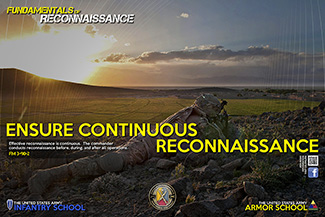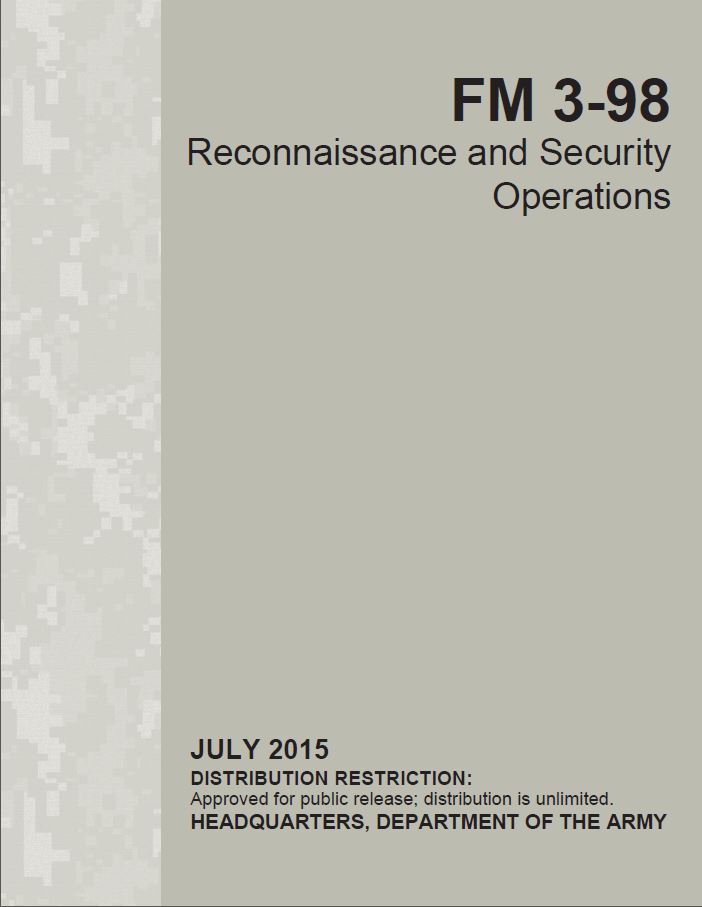ENSURE CONTINUOUS RECONNAISSANCE
Effective reconnaissance is continuous. The commander conducts reconnaissance before, during, and after all operations. Before an operation, reconnaissance fills gaps in information about the enemy, the terrain, and civil considerations. During an operation, reconnaissance provides the commander with updated information that verifies the enemy's composition, dispositions, and intentions as the battle progresses. This allows the commander to verify which potential COA the enemy is attempting to execute and determine if the friendly plan is still valid based on events in the AO. However, the commander may have some reconnaissance elements determine and report civilian activities in population nodes during operations. The commander may have reconnaissance elements report friendly unit locations, status, and sustainment requirements during chaotic situations, such as after a chemical, biological, radiological, nuclear, or high-yield explosive (CBRNE) event. After an operation, reconnaissance elements maintain contact with the enemy to determine the enemy's next move and collect information, including terrain and civil considerations, necessary for planning subsequent operations. When current operational information is adequate, reconnaissance elements gather information for branches and sequels to current plans. As a minimum, reconnaissance is conducted continuously as part of all security missions, including the conduct of local security for forces not in contact. As operations transition from a focus on one element of operations to another, the nature of the PIR and information requirements being collected against will change. It is important that all Soldiers act as sensors and report their observations in a timely manner to a competent authority.
Reed’s Bridge
Era: American Civil War
In the days preceding the battle of Chickamauga, the roads in northwest Georgia were filled with columns of marching and countermarching soldiers as the Union Army of the Cumberland and the Confederate Army of Tennessee maneuvered in preparation for battle. By mid-September, General Rosecrans had begun to concentrate Union forces, but the action took time. Most of his army remained south of Chattanooga, while smaller forces garrisoned the town and occupied key locations nearby. General Bragg’s Army of Tennessee sought to engage and destroy a portion of Rosecrans’ army before it could be reinforced. Alternatively, he sought to interpose his Confederate army between Rosecrans and the main Union supply depot at Chattanooga, forcing an engagement.
Critical to Union planning lay the determination of Bragg’s location and intent. Therefore mounted forces, including Colonel H.G. Minty’s cavalry brigade, were dispatched to find the Confederates. Minty’s mission also included screening the northern or left flank of Rosecrans’ consolidating army. On 15 September the Union cavalry crossed Chickamauga Creek at Reed’s Bridge and pushed patrols eastward toward Ringgold. Minty’s troopers initially found little sign of Confederate activity, but they did identify several potential crossing sites over the Chickamauga that enemy forces might use. On the 17th a probe toward the town by Union infantry encountered a concentrated force of Confederates and retired. Minty also noted the enemy presence and the apparent northward shift of Bragg’s army in preparation for a thrust across the Chickamauga into the left flank of Rosecrans’ still consolidating forces. This information concerning Confederate activity was reported to Minty’s chain of command. He also maintained patrols to observe the Confederates at Ringgold. His actions triggered the dispatch of additional Union mounted elements to cover crossings over the Chickamauga on each of his flanks.
Fundamentals of Reconnaissance:
- Gain and maintain contact
- Minty’s patrols located and tracked Confederate troop movements into and around Ringgold in accordance with his original instructions
- Orient on the reconnaissance objective
- Minty remained focused upon obtaining information on enemy troop locations and movements, resulting in his correct identification of the Confederate concentration at Ringgold and its likely purpose
- Report information rapidly and accurately
- Minty provided at least nine reports to his corps commander in four days with most of the reports arriving across several miles within a few hours. He also sent reports to other Union commanders in his vicinity to keep them apprised of the tactical situation. He relied upon a network of dispatchers to sustain these communication links.
- Ensure continuous reconnaissance
- The regular use of small patrols during the day and at night to monitor activities at Ringgold enabled Minty to accurately locate, monitor, and forecast Confederate intentions and forces.
- Retain freedom of maneuver
- Minty’s success in finding and tracking Confederate forces stemmed from his ability to avoid becoming decisively or unnecessarily engaged in combat operations.
Amid growing signs of Confederate activity, Minty transitioned from a reconnaissance to a security mission. He established a series of picket lines to provide early warning of an enemy advance and deployed his initial screen line along the Pea Valley Ridge, which lay astride the main route any force headed for Reed’s Bridge would have to take. Minty understood his role as providing early warning to Rosecrans and delaying any hostile advance in order to provide reaction time for his commander.
On 18 September the Confederates at Ringgold advanced to seize the crossing at Reed’s Bridge. Led by Brigadier General Nathan B. Forrest, the mixed force of infantry and cavalry quickly drove the Union pickets back. Minty’s initial screen line, however, provided sufficient resistance to force the Confederates to deploy into combat formations and conduct an assault—a process that in the linear tactics of the day required time. Before becoming decisively engaged, Minty withdrew to a second position where most of his brigade deployed. The Confederates advanced but had once again to deploy and commit most of their infantry to combat. A preemptive mounted strike by part of Minty’s command further encouraged caution among the Southern commanders.
As Confederate pressure mounted, and facing possible envelopment by Forrest’s cavalry, Minty conducted a fighting withdrawal across Reed’s Bridge. There he occupied a new defensive position and continued to contest the crossing site, though efforts to dismantle the wooden bridge failed. Throughout this action, Minty sent a steady stream of messages to his command chain and to those mounted elements defending adjacent positions along the Chickamauga.
Minty’s stubborn resistance resulted in additional Confederate forces being committed to battle. By late afternoon, however, he could no longer justify defending the Reed’s Bridge area. Union forces protecting other crossing sites had retired under enemy pressure, while Forrest’s cavalry had found an undefended ford to Minty’s south. Facing encirclement and increasingly isolated, Minty withdrew. His actions delayed Confederate operations for an entire day, which Rosecrans used to complete the concentration of army. When Bragg’s Army of Tennessee began its attacks on 19 September, marking the start of the two day battle of Chickamauga, it faced a Union army prepared for battle.
Fundamentals of Security:
- Provide early and accurate warning
- Minty’s mission entailed providing General Rosecrans advance warning of any Confederate effort to move between his army and Chattanooga
- At Reed’s Bridge Minty relied upon a series of picket lines to ensure early notice of any Confederate movement from Ringgold toward the crossing site. When Forrest moved to take the bridge, initial contact came with Minty’s pickets
- Provide reaction time and maneuver space
- Minty’s action at Reed’s Bridge disrupted Confederate operations for a day, providing General Rosecrans critical time in which to concentrate his army and prepare for battle. Minty relied upon the proven tactic of sustaining a defensive position just long enough to force the Confederate infantry into time consuming battle deployments before he retired to his next battle position. In this manner, less than 1,000 Union troopers delayed over 7,000 Confederate soldiers for nearly 10 hours.
- Orient on the force or facility to be secured
- Minty remained between the Confederates at Ringgold and the Chickamauga crossing at Reed’s Bridge throughout his delaying action until finally forced to retire.
- Perform continuous reconnaissance
- Minty relied upon regular day and night patrols to ensure uninterrupted situational awareness
- Maintain enemy contact
- At no point did Minty lose contact with the Confederates once he located their position at Ringgold. From that point through the fighting on 18 September, he monitored their action and shared reports of enemy activity with adjacent commanders.


